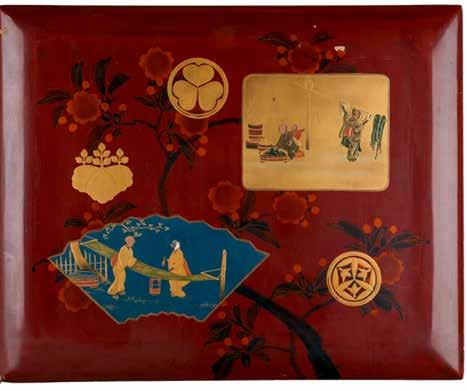The birth of the samurai class Russell Kelty
Samurai means ‘to wait upon or to serve’ and it is this, above all other roles, that defines their place in society. As the hereditary military class, which includes the shogun, daimyo and various classifications of their retainers, the samurai were entrusted with serving and safeguarding the Emperor and administering the archipelago. Evidence of a warrior culture in Japan appears in the form of iron body armour, helmets and straight swords, created from the third century BCE. Armour and helmets were made from pieces of iron, bound together with leather fixings and rivets, creating a durability and flexibility suited to warfare on horseback with bow and arrow. Innovations over the preceding centuries resulted in curved swords, which were the envy of East Asia, flexible lightweight armour and accoutrements of exceptional quality. Standing figures created in terracotta (haniwa) (fig. 1) and stone (sekijin), wearing armour, swords and quivers have been found at the site of megalithic keyhole-shaped tombs in Japan.1 It is believed these figures functioned as guardians of the treasures inside the tomb and delineated sacred space. The earliest chronicles of Japan, compiled in the eighth century, describe the creation of the archipelago, as well as provide genealogical and anecdotal history of the imperial court and prominent clans. These chronicles not only recount the heroic struggles of the Emperors but also those of the Empresses. The birth of the samurai occurred during the Heian period (795–1185), as the aristocracy of Kyoto indulged in the intrigues of the court and presided over a spectacular blossoming of art and culture. Imperial armies were disbanded and the conscription system abolished, leaving the security of provincial estates to the clan chieftains and governors appointed from the middle ranks of the aristocracy.2 The governors were often provided with clan names such as Minamoto and Taira, members of which in the following centuries would vie for dominion over the archipelago. At times, the Emperor appointed a commander as the sei i tai shogun or ‘barbarian-subduing great general’ on expeditions to the north of Kyoto to expand territory or subdue the indigenous clans (emishi). These expeditions were comprised of fast-moving mounted archers. As these estates became more independent from the court and took on peacekeeping responsibilities, they hired armed retainers, who provided their own horses and equipment, requiring substantial resources. These provincial gentry were called samurai. Independent of the imperial court, these rural clans developed a feudal, familial structure, based on a mutually beneficial relationship between lord and vassal.3 The samurai were encouraged to lead frugal and strenuous lives, hone their martial skills, practise hunting and hawking, and to value courage, honour and loyalty. It was the samurai in the east of Japan who refined the way of the bow and horse (kyuba no michi) with lethal efficiency. 6
fig. 1: Japan, Kofun period, 6th century, Warrior in Keiko Armour Haniwa (Terracotta tomb figurine), Iizuka-machi, Ota Citi, Gunma, 130.5 cm (height); Tokyo National Museum J36697 1 Tokyo National Museum, Colbase, Warrior in Keiko Armour Haniwa (Terracotta tomb figurine), J-36697, <https://colbase.nich.go.jp/collection_items/tnm/J36697?locale=en>. 2 J. Gabriel Barbier-Mueller (ed.), Art of armor: Samurai armor from the Ann and Gabriel BarbierMueller Collection, Yale University Press, New Haven, 2011, p. 31. 3 Vassals were designated as housemen (kenin) or children of the house (ienoko) and the lords were viewed as their fathers.

















